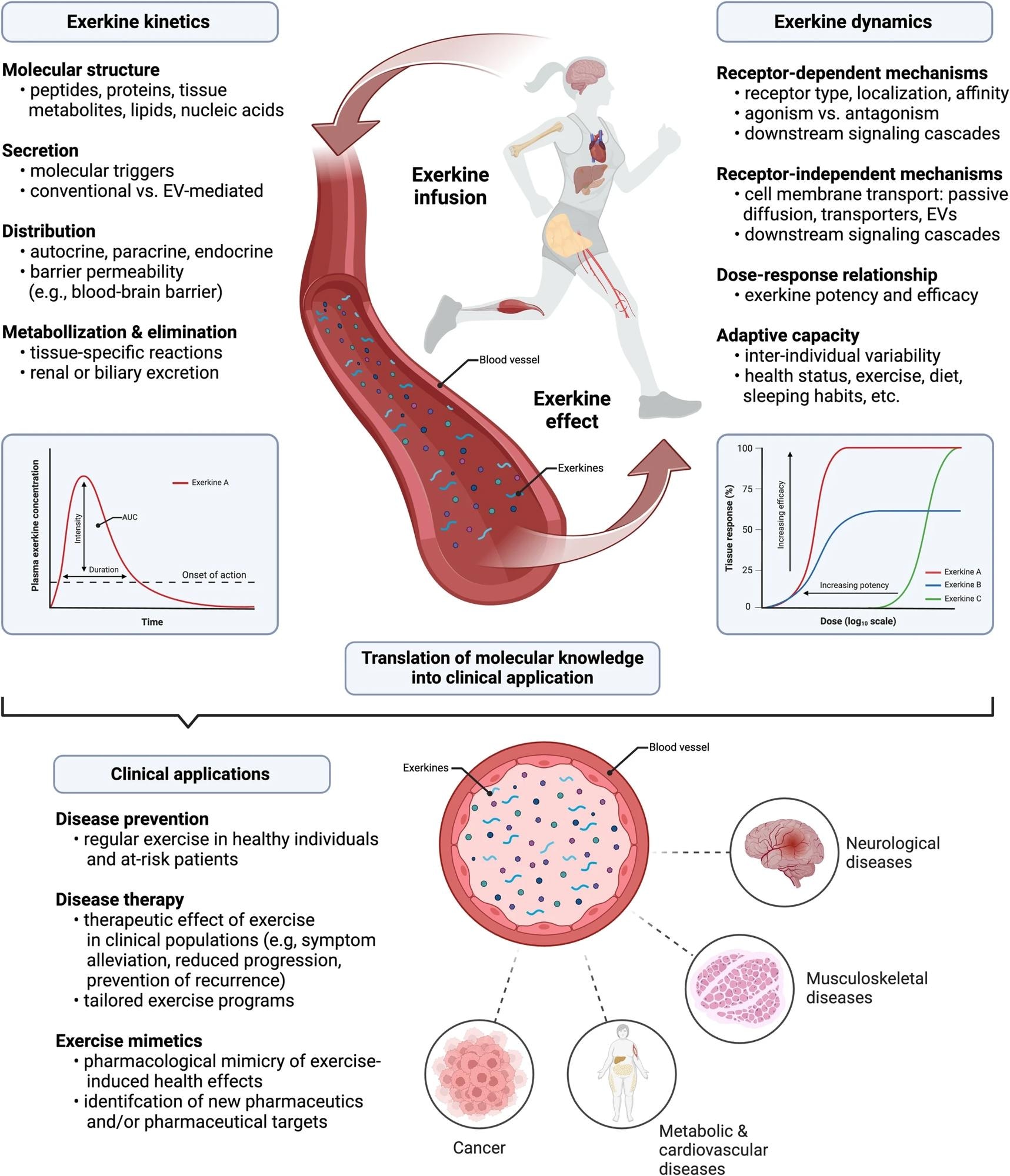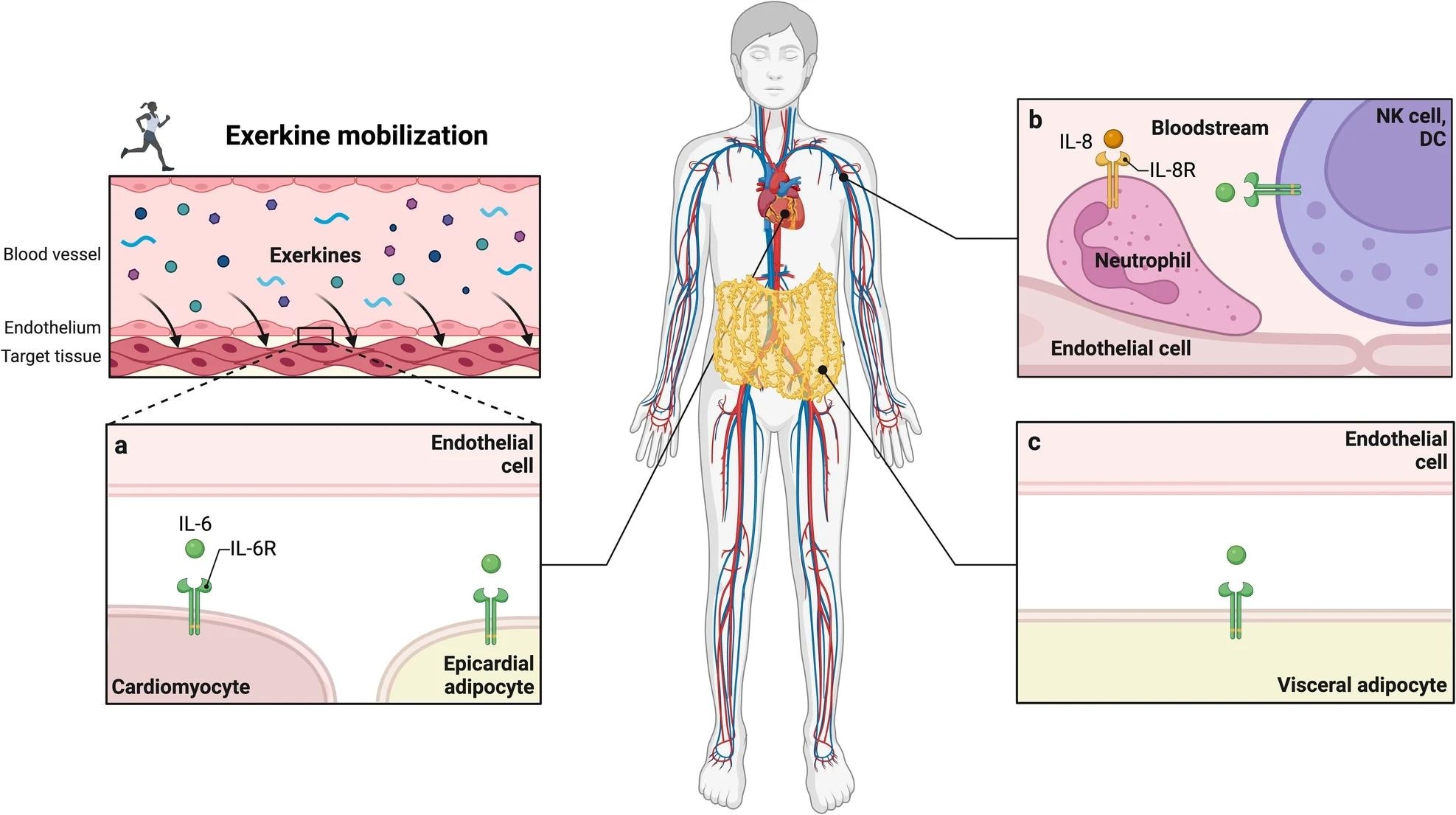Physical inactivity is linked to various chronic diseases, while physical activity is known to help prevent them. Exercise training, involving structured, repeated bouts of activity, serves as a cost-effective intervention to improve health and prevent conditions like cancer, cardiovascular, metabolic, and neurodegenerative diseases. Acute exercise regulates physiological parameters to meet the demands of active tissues, leading to long-term tissue adaptations that enhance and protect overall health. Despite known benefits, the molecular mechanisms of these adaptations are not fully understood.
Researchers have identified exerkines, exercise-induced molecules that mediate tissue communication and drive adaptations. Understanding exerkine kinetics and dynamics is crucial for optimizing exercise prescription for disease prevention and treatment and developing exercise-mimicking pharmaceuticals. In the present review, researchers explored the tissue-wide health effects of exercise, focusing on the cellular mechanisms and signaling pathways of exerkines and their clinical relevance.
What are exerkines?
Exerkines vary in molecular structure, including peptides, proteins, metabolites, lipids, and nucleic acids, and can be classified by function as hormones, cytokines, or chemokines. Peptides and proteins are central to intercellular communication, with hundreds identified as mobilized by exercise, influencing health outcomes like anti-obesity and anti-diabetic effects. Metabolites such as lactate and succinate also play signaling roles, contributing to tissue remodeling and systemic energy balance. Non-coding ribonucleic acids (RNAs) regulate gene expression and contribute to exercise-induced adaptations in tissues like muscle and heart, with potential therapeutic applications.
 Molecular exercise therapy: mode of action and clinical implications of exercise-induced signaling molecules (exerkines). The effect of exerkines on the human organism can broadly be divided into exerkine kinetics and exerkine dynamics. During acute exercise, numerous exerkines are secreted in an autocrine, paracrine and/or endocrine manner. In the case of endocrine secretion, these exerkines are distributed throughout the human organisms, making them available to distinct target tissues. The intensity and duration of an exerkine effect is dictated by the exerkine concentration over time (area under the curve, AUC), which, in case of endocrine secretion, can be quantified as plasma exerkine levels. For autocrine and paracrine secretion, microdialysis or other techniques for isolation of extracellular fluids allow precise quantification of tissue-specific exerkine concentrations and determination of exerkine concentration-time curves. Of note, exerkines might also be subject to metabolization and elimination via distinct routes. Once exerkines are secreted, they interact with target cells in a receptor-dependent or receptor-independent manner. For receptor-dependent interactions, the effect on target cells depends on the precise characteristics of the target receptor and the exerkine–receptor interaction. The intrinsic activity of an exerkine (agonism vs. antagonism), its affinity to the target receptor, and the receptor density on target cells dictate dose-response relationships for exerkine-exerkine receptor pairs that determine the potency and efficacy of an exerkine. For receptor-independent mechanisms, passive diffusion across the cell membrane, transmembrane transporters, and extracellular vesicle (EV)-mediated uptake of exerkines have been described. Once exerkines have entered the intracellular space, they can trigger signal transduction and subsequent adaption processes in a distinct fashion. These molecular characteristics as well as inter-individual differences in health status and lifestyle habits (e.g., diet, exercise, sleeping behavior) determine the magnitude of tissue adaption. Transferring mechanistic knowledge on exerkine kinetics and exerkine dynamics into disease context has promising clinical implications, e.g., in disease prevention, targeted exercise therapy and the development of novel, exercise-inspired pharmaceutics (i.e., exercise mimetics). Created with BioRender.com
Molecular exercise therapy: mode of action and clinical implications of exercise-induced signaling molecules (exerkines). The effect of exerkines on the human organism can broadly be divided into exerkine kinetics and exerkine dynamics. During acute exercise, numerous exerkines are secreted in an autocrine, paracrine and/or endocrine manner. In the case of endocrine secretion, these exerkines are distributed throughout the human organisms, making them available to distinct target tissues. The intensity and duration of an exerkine effect is dictated by the exerkine concentration over time (area under the curve, AUC), which, in case of endocrine secretion, can be quantified as plasma exerkine levels. For autocrine and paracrine secretion, microdialysis or other techniques for isolation of extracellular fluids allow precise quantification of tissue-specific exerkine concentrations and determination of exerkine concentration-time curves. Of note, exerkines might also be subject to metabolization and elimination via distinct routes. Once exerkines are secreted, they interact with target cells in a receptor-dependent or receptor-independent manner. For receptor-dependent interactions, the effect on target cells depends on the precise characteristics of the target receptor and the exerkine–receptor interaction. The intrinsic activity of an exerkine (agonism vs. antagonism), its affinity to the target receptor, and the receptor density on target cells dictate dose-response relationships for exerkine-exerkine receptor pairs that determine the potency and efficacy of an exerkine. For receptor-independent mechanisms, passive diffusion across the cell membrane, transmembrane transporters, and extracellular vesicle (EV)-mediated uptake of exerkines have been described. Once exerkines have entered the intracellular space, they can trigger signal transduction and subsequent adaption processes in a distinct fashion. These molecular characteristics as well as inter-individual differences in health status and lifestyle habits (e.g., diet, exercise, sleeping behavior) determine the magnitude of tissue adaption. Transferring mechanistic knowledge on exerkine kinetics and exerkine dynamics into disease context has promising clinical implications, e.g., in disease prevention, targeted exercise therapy and the development of novel, exercise-inspired pharmaceutics (i.e., exercise mimetics). Created with BioRender.com
Exerkines are secreted through various mechanisms, including the endoplasmic reticulum-Golgi pathway for proteins and mass action for metabolites. Extracellular vesicles are another important mode of secretion, protecting exerkines from degradation and enabling distant tissue communication. Once secreted, exerkines can signal locally or systemically, sometimes crossing barriers like the blood-brain barrier to affect the central nervous system (CNS).
Exerkine-induced signal transduction and biological tissue adaption
The process of exerkine-mediated tissue adaptation involves both receptor-dependent and receptor-independent signal transduction mechanisms. Receptor-dependent mechanisms involve specific cellular receptors, such as G protein-coupled receptors, tyrosine kinase receptors, or cytokine receptors. On the other hand, receptor-independent mechanisms involve interactions with target cells in a manner that does not require specific receptors.
Exerkine-mediated tissue adaptation has been extensively studied in various tissues, including skeletal muscle, cardiac muscle, and white adipose tissue. Exerkines contribute to endurance adaptations, anti-sarcopenic effects, and metabolic improvements in skeletal muscle. Cardiac muscle exhibits adaptations in response to exercise, including myocardial hypertrophy and improved cardiac function, mediated by apelin, neuregulin 1, and meteorin-like (METRNL) exerkines. In white adipose tissue, exerkines like irisin and METRNL induce adipose tissue browning, leading to metabolic improvements and reduced obesity-related complications. Exerkines like β-aminoisobutyric acid (L-BAIBA) and irisin show potential for osteogenic adaption, offering therapeutic avenues for age-related bone loss, while mechanical strain triggers local lipolysis that facilitates osteogenesis. Exerkines impact CNS function via mechanisms involving brain-derived neurotrophic factor (BDNF) and angiogenesis, while peripheral nerves undergo tissue adaption influenced by muscle-secreted factors like neurturin.
Animal studies reveal tissue-wide effects of exerkine receptors, linking exercise to tissue-specific outcomes. While promising for therapeutics, few studies translate findings to humans, hindered by ethical constraints. Pharmacological blockade and imaging techniques offer avenues for human research, with potential monoclonal antibodies showing promise.
 Overview of exerkine receptors investigated in human trials. Due to methodological and ethical constraints of mechanistic exercise studies in humans, exerkine receptor activation is harder to investigate in humans compared to animals. Exerkine target tissues that have been investigated in humans comprise cardiac muscle tissue and epicardial adipose tissue (a), neutrophils, natural killer cells, and dendritic cells (b), and visceral adipose tissue (c). IL-6R interleukin-6 receptor, IL-8R interleukin-8 receptor, NK cell natural killer cell, DC dendritic cell, IL-6R interleukin 6 receptor, IL-8R interleukin 8 receptor. Created with BioRender.com
Overview of exerkine receptors investigated in human trials. Due to methodological and ethical constraints of mechanistic exercise studies in humans, exerkine receptor activation is harder to investigate in humans compared to animals. Exerkine target tissues that have been investigated in humans comprise cardiac muscle tissue and epicardial adipose tissue (a), neutrophils, natural killer cells, and dendritic cells (b), and visceral adipose tissue (c). IL-6R interleukin-6 receptor, IL-8R interleukin-8 receptor, NK cell natural killer cell, DC dendritic cell, IL-6R interleukin 6 receptor, IL-8R interleukin 8 receptor. Created with BioRender.com
Exercise therapy in disease prevention and treatment
Exercise therapy offers preventive and therapeutic benefits across various diseases, affecting multiple organ systems simultaneously. Preclinical studies highlight the role of exerkines in metabolic, cardiovascular, neurological, and musculoskeletal diseases and cancer. Translational evidence supports the therapeutic potential of exerkines in conditions like obesity, type 2 diabetes, cardiovascular diseases, and neurodegenerative disorders. Clinical trials, including those testing exerkine analogs, demonstrate promising results, but further research is needed for broader implementation. Exercise remains a holistic intervention, with the simultaneous release of numerous exerkines contributing to its health-promoting effects. Integrating exercise therapy into personalized treatment plans holds significant potential for improving patient outcomes and promoting healthy aging.
Current limitations and future perspectives
Studies often focus on endurance exercise, potentially biasing results. While technological advancements aid in identifying new exerkines, research on their effects on target cells and signaling pathways is lacking. Bridging this gap could inform personalized exercise recommendations for disease management and pave the way for exercise-mediated prevention and treatment strategies.
Conclusion
In conclusion, the review outlines how exerkine signaling cascades contribute to tissue adaptation, potentially preventing and treating chronic diseases. It emphasizes exerkine target receptors as key mediators and highlights the importance of understanding exercise-mediated health benefits from a molecular perspective, bridging the gap between basic research and clinical applications.